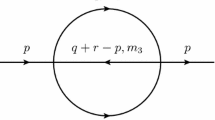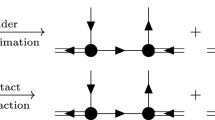Abstract.
We analyze a pion form factor formulation which fulfills the Analyticity requirement within the Hidden Local Symmetry (HLS) Model. This implies an s-dependent dressing of the \(\rho-\gamma\) VMD coupling and an account of several coupled channels. The corresponding function \(F_\pi(s)\) provides nice fits of the pion form factor data from s=-0.25 to s=1 GeV2. It is shown that the coupling to \(K \overline{K}\) has little effect, while \(\omega \pi^0\) improves significantly the fit probability below the \(\phi\) mass. No need for additional states like \(\rho(1450)\) shows up in this invariant-mass range. All parameters, except for the subtraction polynomial coefficients, are fixed from the rest of the HLS phenomenology. The fits show consistency with the expected behaviour of \(F_\pi(s)\) at s=0 up to \({\cal O} (s^2)\) and with the phase shift data on \(\delta_1^1(s)\) from threshold to somewhat above the \(\phi\) mass. The \(\omega\) sector is also examined in relation with recent data from CMD-2.
Similar content being viewed by others
References
1. J. F. De Troconiz, F. J. Yndurain, Precision determination of the pion form factor and calculation of the muon g-2, Phys. Rev. D 65, 093001, (2002), [arXiv:hep-ph/0106025]
2. M. Davier, S. Eidelman, A. Hocker, Z. Zhang, Confronting spectral functions from $e^+ e^-$ annihilation and tau decays: Consequences for the muon magnetic moment, Eur. Phys. J. C 27, 497, (2003), [arXiv:hep-ph/0208177]
3. A. Pich, J. Portoles, Vector form factor of the pion: A model-independent approach, [arXiv:hep-ph/0209224]
4. J. J. Sanz-Cillero, A. Pich, Rho meson properties in the chiral theory framework, Eur. Phys. J. C 27, 587, (2003), [arXiv:hep-ph/0208199]
5. B. Hayms, Nucl. Phys. B 64, 134, (1973)
6. R. Barate, [ALEPH Collaboration], Measurement of the spectral functions of vector current hadronic tau decays, Z. Phys. C 76, 15, (1997)
7. K. Ackerstaff, [OPAL Collaboration], Measurement of the strong coupling constant alpha(s) and the vector and axial-vector spectral functions in hadronic tau decays, Eur. Phys. J. C 7, 571, (1999), [arXiv:hep-ex/9808019]
8. S.D. Protopopescu, Pi Pi Partial Wave Analysis From Reactions Pi+ P $\to$ Pi+ Pi- Delta++ And Pi+ P $\to$ K+ K- Delta++ At 7.1-Gev/c, Phys. Rev. D 7, 1279, (1973)
9. S. Anderson, [CLEO Collaboration], Hadronic structure in the decay tau- $\to$ pi- pi0 nu/tau, Phys. Rev. D 61, 112002, (2000), [arXiv:hep-ex/9910046]
10. G. Ecker, J. Gasser, A. Pich, E. de Rafael, The Role Of Resonances In Chiral Perturbation Theory, Nucl. Phys. B 321, 311, (1989)
11. K. Hagiwara, [Particle Data Group Collaboration], Review Of Particle Physics, Phys. Rev. D 66, 010001, (2002)
12. G. Gounaris, J. Sakurai, Finite Width Corrections To The Vector Meson Dominance Prediction For Rho $\to$ E+ E-, Phys., Rev. Lett. 21, 244, (1968)
13. L. M. Barkov, Electromagnetic Pion Form-Factor In The Timelike Region, Nucl. Phys. B 256, 365, (1985)
14. A. Quenzer , Pion Form-Factor From 480-MeV To 1100-MeV, Phys. Lett. B 76, 512, (1978)
15. R. R. Akhmetshin, [CMD-2 Collaboration], Measurement of e+ e- $\to$ pi+ pi- cross section with CMD-2 around rho-meson, Phys. Lett. B 527, 161, (2002), [arXiv:hep-ex/0112031]
16. M. Benayoun, S. Eidelman, K. Maltman, H. B. O'Connell, B. Shwartz and A. G. Williams, New results in rho0 meson physics, Eur. Phys. J. C 2, 269, (1998), [arXiv:hep-ph/9707509]
17. M. Bando, T. Kugo, K. Yamawaki, Nonlinear Realization And Hidden Local Symmetries, Phys. Rept. 164, 217, (1988)
18. M. Benayoun, H. B. O'Connell, Isospin symmetry breaking within the HLS model: A full ($\rho$, $\omega$, $\Phi$) mixing scheme, Eur. Phys. J. C 22, 503, (2001), [arXiv:nucl-th/0107047]
19. C. D. Froggatt, J. L. Petersen, Phase Shift Analysis Of Pi+ Pi- Scattering Between 1.0-Gev And 1.8-Gev Based On Fixed Momentum Transfer Analyticity, Nucl. Phys. B 129, 89, (1977)
20. T. Fujiwara, T. Kugo, H. Terao, S. Uehara, K. Yamawaki, Nonabelian Anomaly And Vector Mesons As Dynamical Gauge Bosons Of Hidden Local Symmetries, Prog. Theor. Phys. 73, 926, (1985)
21. M. Benayoun, L. DelBuono, S. Eidelman, V.N. Ivanchenko, H.B. O'Connell, Radiative decays, nonet symmetry and SU(3) breaking, Phys. Rev. D 59, 114027, (1999), [arXiv:hep-ph/9902326]
22. M. Benayoun, L. DelBuono, Ph. Leruste, H. B. O'Connell, An effective approach to VMD at one loop order and the departures from ideal mixing for vector mesons, Eur. Phys. J. C 17, 303, (2000), [arXiv:nucl-th/0004005]
23. M. Benayoun, L. DelBuono, H. B. O'Connell, VMD, the WZW Lagrangian and ChPT: The third mixing angle, Eur. Phys. J. C 17, 593, (2000), [arXiv:hep-ph/9905350]
24. M. Benayoun, H. B. O'Connell, SU(3) breaking and hidden local symmetry, Phys. Rev. D 58, 074006, (1998), [arXiv:hep-ph/9804391]
25. M. Benayoun, H. B. O'Connell, A. G. Williams, Vector meson dominance and the rho meson, Phys. Rev. D 59, 074020, (1999), [arXiv:hep-ph/9807537]
26. H. B. O'Connell, B. C. Pearce, A. W. Thomas, A. G. Williams, Constraints on the momentum dependence of $\rho\!-\!\omega$ mixing, Phys. Lett. B 336, 1, (1994), [arXiv:hep-ph/9405273]
27. M. N. Achasov, Recent results from SND detector at VEPP-2M, [arXiv:hep-ex/0010077]
28. M. Bando, T. Kugo, K. Yamawaki, On The Vector Mesons As Dynamical Gauge Bosons Of Hidden Local Symmetries, Nucl. Phys. B 259, 493, (1985)
29. A. Bramon, A. Grau, G. Pancheri, Radiative vector meson decays in SU(3) broken effective chiral Lagrangians, Phys. Lett. B 344, 240, (1995)
30. H. B. O'Connell, B. C. Pearce, A. W. Thomas, A. G. Williams, Rho - omega mixing, vector meson dominance and the pion form-factor, Prog. Part. Nucl. Phys. 39, 201 (1997), [arXiv:hep-ph/9501251]
31. F. Klingl, N. Kaiser, W. Weise, Effective Lagrangian approach to vector mesons, their structure & decays, Z. Phys. A 356 (1996) 193 [arXiv:hep-ph/9607431]
32. D. Melikhov, O. Nachtmann, T. Paulus, The pion form factor at timelike momentum transfers in a dispersion approach, [arXiv:hep-ph/0209151]
33. R. Kaiser, H. Leutwyler, Pseudoscalar decay constants at large N(c), [arXiv:hep-ph/9806336]
34. J. L. Goity, A. M. Bernstein, B. R. Holstein, The decay $\pi^0 \to \gamma \gamma$ to next to leading order in chiral perturbation theory, Phys. Rev. D 66, 076014, (2002), [arXiv:hep-ph/0206007]
35. S. Gardner, H. B. O'Connell, $\rho\!-\!\omega$ mixing and the pion form factor in the time-like region, Phys. Rev. D 57, 2716 (1998) [Erratum-ibid. D 62, 019903 (2000)] [arXiv:hep-ph/9707385]
36. J. Gasser, H. Leutwyler, Chiral Perturbation Theory To One Loop, Annals Phys. 158, 142, (1984)
37. J. Bijnens, G. Colangelo, P. Talavera, The vector and scalar form factors of the pion to two loops, JHEP 9805, 014, (1998), [arXiv:hep-ph/9805389]
38. T. Hannah, The inverse amplitude method and chiral perturbation theory to two loops, Phys. Rev. D 55, 5613, (1997), [arXiv:hep-ph/9701389]
39. T. N. Truong, When is it possible to use perturbation technique in field theory?, [arXiv:hep-ph/0006302]
40. S. R. Amendolia, [NA7 Collaboration], A Measurement Of The Space - Like Pion Electromagnetic Form-Factor, Nucl. Phys. B 277, 168, (1986)
41. E. B. Dally, Elastic Scattering Measurement Of The Negative Pion Radius, Phys. Rev. Lett. 48, 375, (1982)
42. B. Costa de Beauregard, T.N. Pham, B. Pire, T.N. Truong, Inelastic Effect Of The Omega Pi0 Channel On The Pion Form-Factor, Phys. Lett. B 67, 213, (1977)
43. M. Bando, T. Kugo, K. Yamawaki, On The Vector Mesons As Dynamical Gauge Bosons Of Hidden Local Symmetries, Nucl. Phys. B 259, 493, (1985)
44. G. 't Hooft, How Instantons Solve The U(1) Problem, Phys. Rept. 142, 357 (1986)
45. G. Morpurgo, General Parametrization Of The V $\to$ P Gamma Meson Decays, Phys. Rev. D 42, 1497, (1990)
46. T. Feldmann, Quark structure of pseudoscalar mesons, Int. J. Mod. Phys. A 15, 159, (2000), [arXiv:hep-ph/9907491]
47. T. Feldmann, P. Kroll, Mixing of pseudoscalar mesons, Phys. Scripta T 99, 13, (2002), [arXiv:hep-ph/0201044]
Author information
Authors and Affiliations
Additional information
Received: 13 January 2003, Revised: 12 March 2003, Published online: 2 June 2003
Rights and permissions
About this article
Cite this article
Benayoun, M., David, P., DelBuono, L. et al. The pion form factor within the hidden local symmetry model. Eur. Phys. J. C 29, 397–411 (2003). https://doi.org/10.1140/epjc/s2003-01234-1
Issue Date:
DOI: https://doi.org/10.1140/epjc/s2003-01234-1




